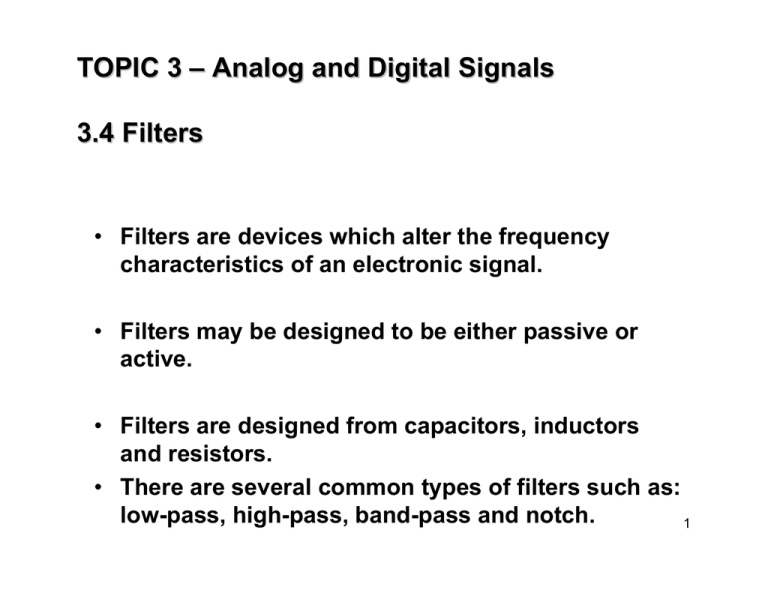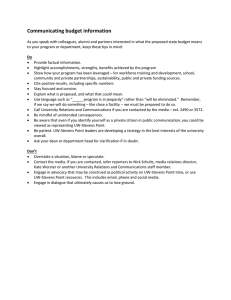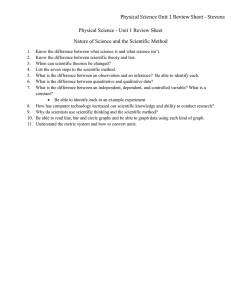
TOPIC 3 – Analog and Digital Signals
3.4 Filters
• Filters are devices which alter the frequency
characteristics of an electronic signal.
• Filters may be designed to be either passive or
active.
• Filters are designed from capacitors, inductors
and resistors.
• There are several common types of filters such as:
low-pass, high-pass, band-pass and notch.
1
TOPIC 3 – Analog and Digital Signals
3.4 Filters
BLOCK DIAGRAM
Input Signal,
T()in
FILTER
Output Signal,
T()out
2
TOPIC 3 – Analog and Digital Signals
3.4 Filters
Remember Impedance:
•Electrical components have responses that vary with
frequency.
•This frequency response is known as impedance, Z.
•Impedance has both a real and a complex part and is of the form:
Z = R + jX where X is called Reactance.
•So the following relationships hold:
•Resistor: Z = R + 0*j = R
•Capacitor: Z = 0 – j/ C = 1j/ C
•Inductor: Z = 0 + L = L
–Where = omega = 2* Pi * frequency in Hz
TOPIC 3 – Analog and Digital Signals
3.4 Filters
Low Pass Filter (LPF) Circuits
4
TOPIC 3 – Analog and Digital Signals
3.4 Filters
Low Pass Filter (LPF) Response
Filter response, T(w)out for either the RC circuit or
the RL circuit is:
• T(w)out = 1/(1+j /c)
•Where the c = cutoff frequency is:
• c = 1/RC for the RC circuit and
• c = R/L for the RL circuit
5
TOPIC 3 – Analog and Digital Signals
3.4 Filters
Low Pass Filter (LPF) Response
6
TOPIC 3 – Analog and Digital Signals
3.4 Filters
Low Pass Filter (LPF) Uses
•Typical use in bioinstrumentation; remove RF interference
from an EKG signal.
•Source of RF: unshielded leads or long connecting
wires/cables.
•Typical cutoff frequency is 150 Hz
7
Low Pass RC Filters
8
TOPIC 3 – Analog and Digital Signals
3.4 Filters
High Pass Filter (HPF) Circuits
9
TOPIC 3 – Analog and Digital Signals
3.4 Filters
High Pass Filter (HPF) Response
Filter response, T(w)out for either the RC circuit or
the RL circuit is:
• T(w)out = 1/(1-j c/)
•Where c = cutoff frequency is:
• c = 1/RC for the RC circuit and
• c = R/L for the RL circuit
10
TOPIC 3 – Analog and Digital Signals
3.4 Filters
High Pass Filter (LPF) Response
11
TOPIC 3 – Analog and Digital Signals
3.4 Filters
High Pass Filter (HPF) Uses
•Typical use in bioinstrumentation: remove dc offset and
other low frequency interference from an EKG signal.
•Typical cutoff frequency: .5 Hz
12
High Pass RC Filters
0V
0V
DC Offset
13
TOPIC 3 – Analog and Digital Signals
3.4 Filters
Bandpass Filter (BPF) Response
14
TOPIC 3 – Analog and Digital Signals
3.4 Filters
Notch (Bandstop) Filter (NPF) Response
15
Modulation - baseband signals
•
Consider a baseband signal, consisting of a few sinusoids. Examine the signal
in the time domain and in the frequency domain:
i
2
bi
EE585WS
10/4/2010
2
40
0
2
•
i
2
Bk
0
0.5
1
0
ti
1
40
20
0
0
0
0
10
20
fk
30
25
This signal cannot be transmitted very far in its present format, nor can we allow
multiple users to share the same spectrum, so the signal has to be modulated
onto a “carrier”
Copyright ©2003-2007
Stevens Institute of Technology - All rights reserved
2-1
Modulation - passband signals
•
By “translating” the previous signal to a “carrier” frequency, we obtain a
passband signal:
2
mi
2
•
2
16
Mk
0
2
0.5
1
0
ti
T
0
900
950
900
1000
fk
1050
1100
1100
This signal has all of its energy near the carrier frequency, in this case 1000 Hz
16
Mk
20
10
0
0
0
0
EE585WS
10/4/2010
10
0
0
20
500
1000
1500
fk
Copyright ©2003-2007
Stevens Institute of Technology - All rights reserved
2000
2000
2-2
Modulation - a generic communications system
•
Consider a simple communications system:
Information
Source
EE585WS
10/4/2010
Transmitter
Receiver
Copyright ©2003-2007
Stevens Institute of Technology - All rights reserved
Information
Sink
2-3
Modulation - a generic communications system
•
Consider a simple communications system:
Information
Source
EE585WS
10/4/2010
Transmitter
Transmission
Channel
Copyright ©2003-2007
Stevens Institute of Technology - All rights reserved
Receiver
Information
Sink
2-4
Modulation - a generic communications system
•
Consider a simple communications system:
Information
Source
Transmission
Channel
Transmitter
Coder
Modulator
Receiver
Demodulator
Information
Sink
Decoder
Passband
signal
Baseband signal
EE585WS
10/4/2010
Copyright ©2003-2007
Stevens Institute of Technology - All rights reserved
2-5
Modulation - modifiable signal parameters
•
Consider a generic equation for a modulated signal m(t), generated by a
baseband signal b(t). Start with an unmodulated carrier signal:
m(t ) Ac cos( wc t c )
•
we can modulate the carrier’s
• amplitude (as set by mA)
• frequency (as set by mf), or
• phase (as set by mp)
Or multiple parameters could be modulated simultaneously
m(t ) Ac 1 mAb(t ) cos(( wc m f b(t ))t m p b(t ) c )
EE585WS
10/4/2010
Copyright ©2003-2007
Stevens Institute of Technology - All rights reserved
2-6
Analog
modulation - AM
i
2
bi
2.888
40
2
Bk
0
0.5
1
0
ti
1
40
20
0
0
0
10
0
20
30
fk
25
With the baseband signal as before, set mA to 1 (100% modulation) and the
other modulation parameters to zero to obtain a purely AM signal
5
mi
0
2.886
5
32
Mi
0
0.5
ti
1
1
40
32
Mk
20
0
0
EE585WS
10/4/2010
2
0
2
•
i
0
1.79610
0
0
1000
2000
fi
3000
2.04810
3
Copyright ©2003-2007
Stevens Institute of Technology - All rights reserved
40
20
14
0
950
950
1000
1050
fk
1.0510
3
2-7
Detecting AM
•
There are two types of AM detectors:
– envelop detectors
m(t)
2
4
2
envelop_detecti
2
leaky_integratori
1
0
0
0
0
2.888
0
0.5
0
ti
1
0
0.5
1
1
0
ti
1
0
0.5
1
0
ti
1
– and synchronous detectors
BB-LPF
m(t)
2.888
4
1.654
2
1
sync i
cos(ct+)
si
0
0.607
2
0
0.359
0
0.5
0
th
EE585WS
10/4/2010
2
d l t d i
lh d
ti
1
1
th
Copyright ©2003-2007
Stevens Institute of Technology - All rights reserved
1
2-8
FM and PM
•
FM and PM can be thought of as the same modulation technique with proper
choice of the input signal:
– Define the instantaneous phase of a sinusoid:
t
(t ) ( x)dx
– so, by integrating the modulating waveform presented to a phase
modulation system, we have a frequency modulation system. And
conversely, by differentiating the input to a frequency modulated system, we
have a phase modulated system.
EE585WS
10/4/2010
Copyright ©2003-2007
Stevens Institute of Technology - All rights reserved
2-9
Bandwidth requirements of FM/PM systems
•
Again, consider the earlier baseband modulating signal, this time frequency
modulating the carrier.
2
mi
2
8.593
0
Mi
5
0.015
0
2
0
0
EE585WS
10/4/2010
10
2
0.5
ti
1
1
8.593
0
0
1000
2000
fi
3000
2.04810
3
Copyright ©2003-2007
Stevens Institute of Technology - All rights reserved
10
Mk
5
0.274
0
950
950
1000
1050
fk
1.0510
3
2-10
Bandwidth requirements of FM/PM systems
•
An FM signal with a simple sinusoidal modulating waveform
M fft( m)
2
2
mf 5 s
-1
15
10.332
10
10
mi
Mi
Mk
0
5
5
2
2
0
0.5
1
0
ti
1
0
950
2.16510
1000
3
0
1050
mf 2 s
22.822
EE585WS
10/4/2010
2
0
0.5
1
0
ti
1
2.04810
3
30
10
10
2
fi
3000
Mi
Mk
0
2000
20
20
mi
1000
-1
30
2
0
0
fk
M fft( m)
2
15
0
950
4.21410
1000
1050
fk
Copyright ©2003-2007
Stevens Institute of Technology - All rights reserved
3
0
0
0
1000
2000
fi
3000
2.04810
3
2-11
Modulating an FM signal
•
Generic FM modulator:
Oscillator circuit
Input signal
EE585WS
10/4/2010
Frequency-modulated
signal
Signal-sensitive
Frequency
determining
elements
Copyright ©2003-2007
Stevens Institute of Technology - All rights reserved
2-12
Demodulating FM
•
Generic FM demodulator:
Frequency-modulated
signal
EE585WS
10/4/2010
Frequency to
voltage converter
Copyright ©2003-2007
Stevens Institute of Technology - All rights reserved
demodulated signal
2-13
Demodulating FM
•
Generic FM demodulator:
Frequency-modulated
signal
•
Frequency to
voltage converter
demodulated signal
Frequency Discriminator:
BPF tuned above
carrier
FM signal
+
-
demodulated
signal
BPF tuned below
carrier
EE585WS
10/4/2010
Copyright ©2003-2007
Stevens Institute of Technology - All rights reserved
2-14
Digital Modulation
•
As before, the generic expression for a modulated signal
m(t ) Ac 1 mAb(t ) cos(( wc m f b(t ))t m p b(t ) c )
•
For digital modulation, b(t) is a digital waveform – discrete in time and level:
b(t ) b(nT ) {l1 , l2 ,..., lm }
•
EE585WS
10/4/2010
The modulated signal “shifts” between discrete states, so digital modulation
techniques are referred to differently than analog modulation:
Analog
Digital
AM
Amplitude Shift Keying (ASK)
FM
Frequency Shift Keying (FSK)
PM
Phase Shift Keying (PSK)
Copyright ©2003-2007
Stevens Institute of Technology - All rights reserved
2-15
M-ary signaling
•
The size of the baseband signaling set may be binary:
b(t ) b(nT ) {l1 , l2 } {0,1}
•
Or M-ary
b(t ) b(nT ) {l1 , l2 ,..., lm }
EE585WS
10/4/2010
Copyright ©2003-2007
Stevens Institute of Technology - All rights reserved
2-16
M-ary signaling
•
The size of the baseband signaling set may be binary:
b(t ) b(nT ) {l1 , l2 } {0,1}
•
Or M-ary
b(t ) b(nT ) {l1 , l2 ,..., lm }
EE585WS
10/4/2010
Copyright ©2003-2007
Stevens Institute of Technology - All rights reserved
2-17
ASK
•
Amplitude Shift Keying (ASK) = On-Off Keying (OOK) if the modulation is 100%
2
bi
0
2
0
0.2
0.4
0.6
0.8
0.6
0.8
ti
2
mi
0
2
0
0.2
0.4
ti
EE585WS
10/4/2010
Copyright ©2003-2007
Stevens Institute of Technology - All rights reserved
2-18
FSK
•
FSK maintains the carrier magnitude
2
bi
0
2
0
0.2
0.4
0.6
0.8
0.6
0.8
ti
1
mi
0
1
0
0.2
0.4
ti
EE585WS
10/4/2010
Copyright ©2003-2007
Stevens Institute of Technology - All rights reserved
2-19
PSK
•
PSK maintains the carrier amplitude and the average carrier frequency
2
bi
0
2
0
0.2
0.4
0.6
0.8
0.6
0.8
ti
1
mi
0
1
0
0.2
0.4
ti
EE585WS
10/4/2010
Copyright ©2003-2007
Stevens Institute of Technology - All rights reserved
2-20
Phasor Representation of Modulated Signals
•
Consider a coordinate system, rotating at the carrier frequency:
c
•
All signal energy at or nearly related to the carrier frequency will be rotating at
approximately the same speed.
– In particular, consider the “on” and “off” periods of an ASK signal
c
EE585WS
10/4/2010
Copyright ©2003-2007
Stevens Institute of Technology - All rights reserved
2-21
Phasor Representation of PSK Signals
•
First, consider a binary PSK system (BPSK). The two transmit phases are
chosen 180 degrees apart.
c
EE585WS
10/4/2010
Copyright ©2003-2007
Stevens Institute of Technology - All rights reserved
2-22
Phasor Representation of PSK Signals
•
First, consider a binary PSK system (BPSK). The two transmit phases are
chosen 180 degrees apart.
c
•
Next, we can consider an m-ary PSK system, e.g., m=4
c
EE585WS
10/4/2010
Copyright ©2003-2007
Stevens Institute of Technology - All rights reserved
2-23
PSK and Quadrature Modulation
•
Is this signal PSK or ASK?
c
EE585WS
10/4/2010
Copyright ©2003-2007
Stevens Institute of Technology - All rights reserved
2-24
PSK and Quadrature Modulation
•
Is this signal PSK or ASK?
c
EE585WS
10/4/2010
c
Copyright ©2003-2007
Stevens Institute of Technology - All rights reserved
c
2-25
PSK and Quadrature Modulation
•
EE585WS
10/4/2010
Is this signal PSK or ASK?
c
c
c
c
c
c
Copyright ©2003-2007
Stevens Institute of Technology - All rights reserved
2-26
Signal Constellation Design
•
EE585WS
10/4/2010
A typical 16-QAM constellation:
Copyright ©2003-2007
Stevens Institute of Technology - All rights reserved
2-27
Filtering Considerations
•
Simplest case for a communications system:
Transmitter
Channel
Receiver
f
EE585WS
10/4/2010
Copyright ©2003-2007
Stevens Institute of Technology - All rights reserved
2-28
Filtering Considerations
•
Simplest case for a communications system:
Noise
Transmitter
Channel
f
EE585WS
10/4/2010
Receiver
f
Copyright ©2003-2007
Stevens Institute of Technology - All rights reserved
2-29
Filtering Considerations
•
Simplest case for a communications system:
Noise
Transmitter
Channel
f
EE585WS
10/4/2010
Filter
Receiver
f
Copyright ©2003-2007
Stevens Institute of Technology - All rights reserved
f
2-30
Filtering Considerations
•
Simplest case for a communications system:
Filter
Noise
Transmitter
Filter
Channel
f
Receiver
f
Filter
f
Filter
f
Transmitter
•
EE585WS
10/4/2010
Receiver
More realistically, there are other users transmitting and receiving signals
Copyright ©2003-2007
Stevens Institute of Technology - All rights reserved
2-31
More Filtering Considerations
•
For the simplest form of modulation, BPSK, generate a random sequence
2
2
bi
0
1
2
0.5
0.52
0.54
.5
f
•
d
0.58
ti
i
0.6
.6001
And look at it in the frequency domain
0.834
Bi
1
0.5
0
0
0
0
EE585WS
10/4/2010
0.56
500
1000
1500
2000
i
Copyright ©2003-2007
Stevens Institute of Technology - All rights reserved
2500
2.04810
3
2-32
Filtering the Baseband signal
•
In the time domain
2
2
b outNG
i
b outOK
0
i
1.429
2
0.5
0.52
0.54
.5
•
0.56
0.58
ti
In the frequency domain
0.884
1
0.834
B NG
i
1
0.5
B OK
i
9.00410
0.5
6
0
0
0
500
1000
1500
i
2000
2500 6.59810 5
2.04810
3
0
0
0
EE585WS
10/4/2010
0.6
.6001
Copyright ©2003-2007
Stevens Institute of Technology - All rights reserved
500
1000
1500
i
2000
2500
2.04810
2-33
3
Examining the “Eye Diagram”
•
Eye diagram for properly filtered signal
2
I0 j
2
1.5
I1 j
I2 j
1
I3 j
I4 j
0.5
I5 j
I6 j
0
I7 j
I8 j
0.5
I9 j
1
•
Eye diagram for over-filtered signal
1.429 1.5
2
I0 j
0
5
2 0
10
15
j
20
19
1.5
I1 j
I2 j
1
I3 j
I4 j
0.5
I5 j
I6 j
0
I7 j
I8 j
0.5
I9 j
1
1.109 1.5
0
0
EE585WS
10/4/2010
Copyright ©2003-2007
Stevens Institute of Technology - All rights reserved
5
10
j
15
20
19
2-34
The Effect of ISI on the Eye Diagram
•
A filter with no ISI
2
2
I0 j
I1 j
I2 j
1
I3 j
I4 j
I5 j
0
I6 j
I7 j
I8 j
1
I9 j
1.429
2
0
5
10
0
•
15
j
20
19
ISI due to the filter dispersion
1.075
I0 j
1.5
1
I1 j
I2 j
0.5
I3 j
I4 j
I5 j
0
I6 j
I7 j
0.5
I8 j
I9 j
1
1.485 1.5
0
0
EE585WS
10/4/2010
5
10
j
15
20
19
Copyright ©2003-2007
Stevens Institute of Technology - All rights reserved
2-35




